
Fatale Review
Publisher: Tale of TalesPlatform: PC, Mac
UK Price (as reviewed): £4 (incl. VAT)
US Price (as reviewed): $7 (excl. Tax)
It’s not a game and you really shouldn’t expect it to be. If you’ve stumbled across this page via Google and are really looking for a review of a film with the same name, or the latest gore-riffic game, then you should probably go elsewhere. There’s a high likelihood that Tale of Tales’ Fatale won’t be to your liking. To be honest, I’m not even sure if it’s to mine – though I’m still struggling to pinpoint why.
Tale of Tales don’t make games though, per se. They make art which just happens to be interactive. They describe Fatale not as a computer game but as an interactive vignette in real-time 3D. There’s no high-score table, no final boss. There’re just three things; a dungeon, a terrace and a dance – but the game isn’t about any of them.
Instead, Fatale is about something dim and peripheral; the type of thing that avoids being looked at directly and resists being summed up by people like me in articles like this. You’d need to give an inordinately articulate art history graduate a beret and a couple of hundred pages to get within grasping range of it, but we’ll do the best we can...
At its most base level, Fatale is about Salome; the biblical character who performed the Dance of Seven Veils for her stepfather King Herod and then, being told she could ask for anything she wanted as a reward for pleasing him, demanded the head of John the Baptist on a silver plate. Her mother supposedly told her to ask for it, having been angry at the imprisoned John after he suggested her wedding was unlawful. That’s not a spoiler by the way – it’s assumed knowledge for anyone approaching Fatale. The game won’t actually tell you these things, which will probably be an issue for some people.
More specifically though, Fatale isn’t just about Salome as a character; it’s about the way she got what she wanted. As the name implies, Fatale is about the dangers of seduction – both explicit and implicit. As Salome seduced Herod using an erotic dance, so too was Salome bent to her mother’s will by an abuse of familial devotion. Fatale makes that obvious by positioning the stern matriarch so that she gazes over an ambivalent Salome, who idles with John’s head nearby, in the second of the game’s three sections.
Or, we think it does anyway. The dangerous brilliance of art like this is that it isn’t always clear what it’s supposed to be saying to the audience, if it’s supposed to be saying anything or how much of the viewer is reflected in the interpretation. Above is simply my own interpretation and, while I could have gone running to the developers to validate my ideas, I’ve chosen not to. This is what I’ve taken away from Fatale and to spend too long dwelling on whether it’s correct or not is to miss the point. I think.
If I’m spending too long talking about the artsy-stuff like the themes and the concepts and so on then there’s a reason for that too; there just isn’t that much gameplay to actually talk about, in all honesty. Again though; gameplay might not be the right word – this isn’t a game, remember?
It’s important to ram that point home for Fatale. Tale of Tales’ previous games haven’t been games either, but they’ve stayed fairly close to them. The Path wasn’t a game, but it could function as one – it gave you choices, freedoms and a more explicit structure and sense of narrative. Fatale doesn’t. If you considered that The Path was an interesting off-shoot or branch of traditional games then you should know that Fatale isn’t simply separated from the main trunk of gaming – it’s an entirely different tree.

MSI MPG Velox 100R Chassis Review
October 14 2021 | 15:04













Want to comment? Please log in.